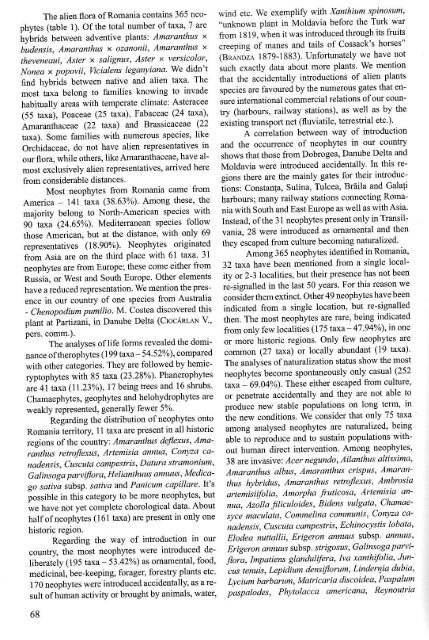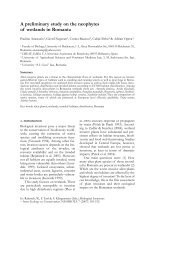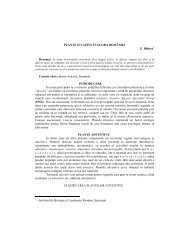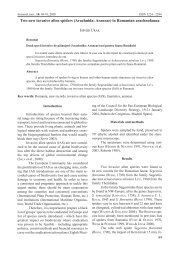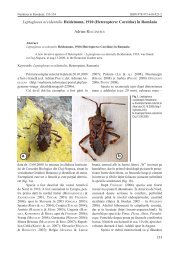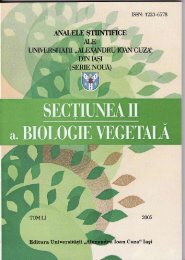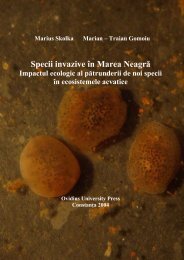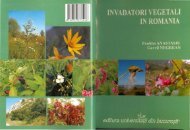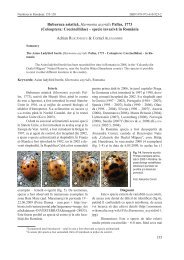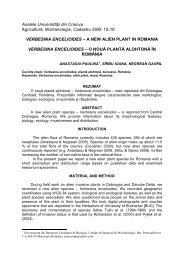You also want an ePaper? Increase the reach of your titles
YUMPU automatically turns print PDFs into web optimized ePapers that Google loves.
The alien flora ofRomania contains 365 neoph)'tes(table 1). Ofthe fotal number of tara, 7 are "unlnowr plaDt in Moldavia before the Tutk warwind etc. We exemplifu with Xanthiufi spinosum'hybrids betrveen adventive plants: Amarunthus x fiom 1819, when it was introduced through its fixitsbudensis, Amatanthus x ozanonii' Amaranthus x creeoinq of manes and tails of Cossack's homes"theveneaui, Aster t salignus' Aster x versicolor, GLAND;A 18?9-1883). Unfortunately we have notNonea x popo|ii, nci\le s legatryiana We didn't such exactly data about more plarts We mentionild hybrids between native and alien taxa The that the accidentally intoductions of alien plantsmost taxa belong to families knowing to invade species are favoured by the numercus gates that ensureinternational commercial rclations ol our coun-habitually areas with t€mperate climate: Astemcee(55 taxa), Poaceae (25 taxa), Fabacea€ (24 taxa), hy Oarbours, railway stations)' as well as by theAmaranthaceae (22 taxa) and Bmssicaceae (22 e;isting transpoft net (fluviatilo, terestrial etc )'taxa). Some families with numerou species, like A conelation between way of introductionOrchidaceae, do not have alien representatives m and the occ|.rlrcnce of neoph''tes in otrl countryour flora, while othels, like Amamnthaceae, have almostexclusively alien representatives, arrived here Molilavia were introduced accidentally ln this re-shows that those ftom Dobrogea, Danube Delta anclfrom considemble distances.sions there are the mainly gates for their introduc_Most neoph''tes from Romania came fiom ;ions: Constanta, Sulina, Tulcea, Briita and Gala1iAmerica - 141 ta'\a (3863%). Aoong these, the harbours; many railway stations connecting Romaniawith South and East Europe as well as with Asia'majority belong to Norih_American species with90 ta-xa (24.65%) Mediterranean species follow lnstead, of the 3 I neoph)'tes present only in Tmnsilvania,28 were introduced as omamental and thenthose American, but at the distance, with only 69representatives (18.90%). Neophltes odginated thev escaped from culture becoming naturalized'from Asia are on the third place with 61 taxa 3l Among 365 neophytes identified in Romania,neophltes are from Europe; these com€ elther rrom 32 taxa have been mentioned from a single localiryor 2-3 localifies, but their prcsmce has not beenRussia, or West and South Europe Other elementshave a reduced representation. We mention the presencein our counhy of one species from ANtralia consialer them extinct. Other 49 neophytes have beenre-signalled in the last 50 years For this reason we- Chen.)podium pnnilio M- Costea discovered this indicated fiom a single location, but re-signalledplant at Pafiizani, in Danube Delta (CIoCARLAN V, then. The most neoph)4es are rarc, being indicatedpers. comm.),fiom only few localities (175 ta"\a 4?'94%)' rn oneThe analyses oflife foms revealed the dominanceoftherophytes (199 taxa 54.52%)' compared common (27 taxa) or locally abundant (19 taxa)'or morc historic regions. Only few neophytes arewith other categories. They are followed by hemicnDrooh\^eswilh 85 l&\a (23.2800) Phanerophllesneophytesbecome spontaneously only casual (252The analyses ofnaturalization status show the mostare 4i Laxa 1l 1.23""1. l7 being tree. and Io shrubs ta-x; 69.04%). These either escaped ftom culhrre,Chamaephytes, geophytes and helohydrophytes are or penehate accidentally and they are not able toweakly represented, generally fewer 5%Drcduce new stable populations on long telm' nRegarding the distribution ofneophytes onto the new conilitions. We consider that only ?5 taxaRomania territory 11 taxa are present in all historic among aralysed neoph''tes ar€ naturalized, beingregions of the country: lmaranlhus de.t'lexus, Ama' able to reproduce and to sustain populations wrthouthuman alirect intervention. Among neophytes,ranthtf rctoflexus, Artemisia 4n ua' Lonyza canaden,t', Cu.tta canpc.lris - Dat ura 5 | rdmonium. 38 are invasive: lcel neSrndo' Ailanthus ctltissima,Galinsoga parvifrora. Helianthuus annuus , Medicagosdtird subsp. sdrivd and Panicum capillare lt's th s lxybridus, Amaranthus retofiexur, AmhrosiaAmarunthus albus, Amaranthus crispus' Amatanpossible in this category lo be more neophytes. bul anemisiifolia, Amotpha fruticos.t' Artemisia annua,Azotla flicutoidas, Biclens wlgdta, Chamae-r.e bare nor )et complele chorological data Abouthalfofneophltes (161 taxa) are present in only one stce fiacul1la, comfielina communis, conyzd canadensis,Cuscuta campestris, Echinoq)stis lobata'histodc region.Regarding lhe \ a) of Inlroduction in our Elodea nuttallii, E gelon ai uus subsp 4'n7r'r'county, the most neophytes werc introduced deliberately(195 taxa - 53.42%) as omamenfal' food, nord, tnpLttien: gtandulUer,l- lva xdnthifolia Jun'Lrigeron annau. sub'p ! trigosur. C alin5c'qa fani'medicinal, bee-keeping, forager, forestry plants etc tus renuit Lepidiun d, n:fforun l incletniu dubia'I 70 neophytes were inhoduced accidentally, as a resultofhuman activity or brought by animals, water, paspalodes, Phytolacca americana'L),cium barbarum, Matricatia discoidea. PasPalumRefnouttia68


